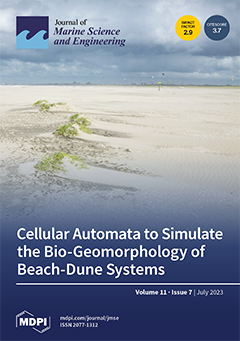Macro-benthos is commonly considered an indicator for evaluating the health of an aquatic ecosystem. Earlier research from sub-tropical mangrove estuaries, however, has primarily relied on conventional taxonomic methods to determine the pattern of macro-benthos diversity. Therefore, this study aimed to describe the pattern of both taxonomic and functional groups of macro-benthos with respect to ecological variables in three separate seasons (pre-monsoon, monsoon, and post-monsoon) from a mangrove-dominated Pasur River estuary, Bangladesh. The findings revealed significant seasonal variations in the water and sediment parameters (
p < 0.05). During the study period, 47 species belonging to 35 families of macro-benthos were identified. The pollution indicator species,
Capitella capitata complex was found to be dominant. The highest density of macro-benthos was recorded in post-monsoon (545 ± 13.76 ind./m
2) followed by pre-monsoon (214 ± 5.57 ind./m
2) and monsoon (63 ± 2.27 ind./m
2). Diversity indices, Shannon, and evenness also displayed a similar seasonal trend. This pattern may be explained by the more stable bottom and higher food availability during post-monsoon, and on the other side, by erosion and higher turbidity during monsoon. Analysis of similarity (ANOSIM) detected a significant difference in community assemblage among the seasons (R = 0.7222,
p = 0.0005), whereas similarity percentage analysis (SIMPER) identified
Dendronereis aestuarina as the most contributory species for the overall average dissimilarity. Six functional feeding groups (FFGs) were identified where gathering collectors (GC) had the highest total density (221.83 ind./m
2) and relative abundance (26.97%). The community was shown to be shaped by the amount of sedimentary silt and dissolved oxygen in the water main, according to a canonical correspondence analysis (CCA) study, they were positively correlated with the abundance of
Pristinella acuminata,
Lumbrineris sp.,
Cossura coasta,
C. capitata complex,
Neritina violacea,
Laccotrephes griseus,
Hydrometra butleri,
Gomphus sp. and
Libellula sp. CCA analysis also revealed a significant positive influence of pH, NO
3-N, PO
4-P, and organic matter, whereas, sand particles of sediments were found to have a negative effect on FFGs. Overall, the study suggests that the estuary is moderately diverse with macro-benthos and their functional feeding groups and influenced by monsoon strongly. The present study on FFGs of macro-benthos in an estuarine river of Bangladesh will provide baseline information for further investigation of other estuaries.
Full article





